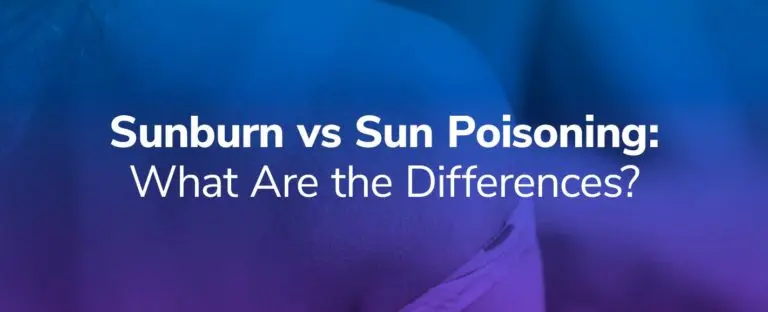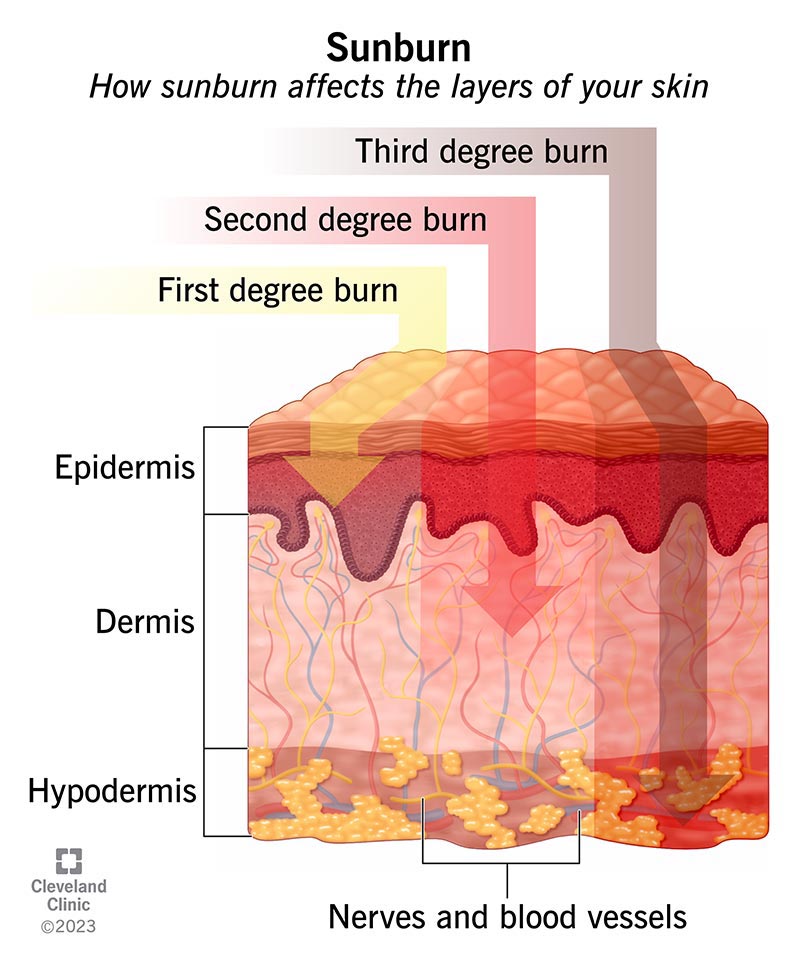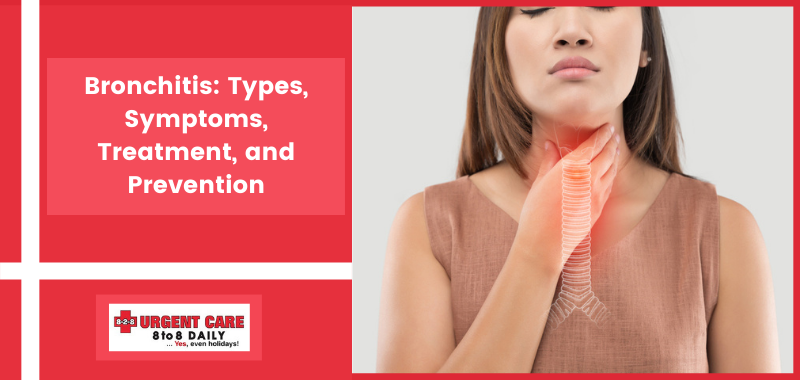Sun poisoning treatment includes drinking extra fluids, taking pain relievers, using aloe gel or moisturizer, and covering sunburned areas outside. Symptoms of sun poisoning may include painful, inflamed skin, blisters, and flu-like symptoms, while prevention measures include staying hydrated, using sunscreen, and seeking shade during peak sun hours.
Sun poisoning can be severe and requires proper care and treatment to alleviate symptoms and prevent further complications.

Types Of Sun Poisoning
Sun poisoning, also known as sunburn, can result in painful, red, and blistered skin and flu-like symptoms. Treatment options include staying hydrated, cooling the affected skin, and taking pain relievers. Preventive measures such as using sunscreen and avoiding excessive sun exposure are crucial to preventing sunburn.
Polymorphic Light Eruption
Polymorphic Light Eruption (PLE) is a common type of sun poisoning that occurs in individuals with sensitivity to sunlight. It typically manifests as a rash or red, itchy bumps on the skin. PLE can appear within hours or even days after exposure to sunlight and is often a recurring condition during the warmer months. The exact cause of PLE is still unknown, but it is believed to be related to an abnormal immune response to sunlight. People with fair skin and a family history of PLE are more susceptible to this type of sun poisoning.
Phototoxic Reaction
A phototoxicSun Poisoning Treatment: Types, Symptoms, And Prevention reaction is another type of sun poisoning caused by certain medications or chemicals that make the skin more sensitive to UV rays. When these substances come into contact with the skin and are exposed to sunlight, they can cause a severe burn-like reaction. Common medications that can trigger phototoxic reactions include certain antibiotics, nonsteroidal anti-inflammatory drugs (NSAIDs), and some topical products. Symptoms of phototoxic reactions may include redness, blistering, and severe pain.
Photoallergic Reaction
The photoallergic reaction is a less common type of sun poisoning that occurs when the immune system reacts abnormally to sunlight. Unlike phototoxic responses, which are immediate, photoallergic reactions may take days or even weeks to develop. These reactions are triggered by specific molecules that undergo a chemical change when exposed to UV light, causing the immune system to produce an allergic response. Common triggers for photoallergic reactions include certain sunscreens, fragrances, and medications. Symptoms may include redness, itching, and blisters.
Symptoms Of Sun Poisoning
Sun poisoning, also known as severe sunburn, can cause painful, red, blistered skin and flu-like symptoms such as headache, fever, chills, nausea, and dehydration. Treatment includes cooling the skin, taking pain relievers, and staying hydrated to relieve symptoms. Prevention is critical, so make sure to protect yourself from future sunburns and lower your risk of skin cancer.
Skin Redness And Blistering
Sun poisoning can cause skin redness and blistering, common symptoms of severe sunburn. When your skin is exposed to excessive amounts of ultraviolet (UV) radiation from the sun, it can lead to inflammation and damage to the skin cells. This can result in redness, tenderness, and the formation of blisters on the affected areas of the skin.
Pain And Tingling
Along with skin redness and blistering, sun poisoning can cause pain and tingling. The damaged skin can become very sensitive and painful to touch. You may experience a burning or stinging sensation, and the affected area may feel hot or itchy. Tingling sensations can also be thought to be due to nerve damage caused by sunburn.
Headache And Fever
In some cases of sun poisoning, individuals may experience symptoms similar to mild flu, such as headaches and fever. Prolonged exposure to the sun can cause inflammation, leading to these flu-like symptoms. It is important to note that a high fever or severe headache could be a sign of a more serious condition, and you should seek medical attention.
Nausea And Dizziness
Sun poisoning can also cause nausea and dizziness. Excessive sun exposure can lead to dehydration and electrolyte imbalances when the body becomes overheated. These imbalances can result in feelings of dizziness, lightheadedness, and even nausea. Staying hydrated and taking breaks in the shade are crucial to preventing these symptoms.
Dehydration
One of the most significant risks of sun poisoning is dehydration. Sunburns can lead to bodily fluid loss, especially if you are not adequately hydrated. Drinking plenty of water and electrolyte-rich fluids is essential to replenishingSun Poisoning Treatment: Types, Symptoms, And Prevention the lost fluids. Dehydration can cause symptoms such as increased thirst, dry mouth, fatigue, and dark-colored urine.
In conclusion, recognizing the symptoms of sun poisoning is crucial for prompt treatment and the prevention of further complications. If you experience severe symptoms such as blistering, intense pain, or a high fever, it is recommended that you seek medical attention immediately. Stay protected from harmful sun exposure by wearing sunscreen, wearing protective clothing, and staying in shaded areas during peak hours.
Prevention And Treatment Of Sun Poisoning
Prevention and treatment of sun poisoning are crucial to protecting your skin and ensuring your overall well-being. You can effectively manage and prevent sun poisoning by taking preventive measures, utilizing home remedies and self-care techniques, and seeking medical treatment options when necessary. Let’s explore each of these aspects in more detail.
Preventive Measures
- Wear protective clothing, such as hats, long-sleeved shirts, and sunglasses, to shield your skin and eyes from harmful UV rays.
- Apply a broad-spectrum sunscreen with a minimum SPF of 30 on exposed skin areas, and reapply every two hours or after swimming or sweating.
- Avoid direct sun exposure during peak hours (10 a.m. to 4 p.m.) when the sun’s rays are the strongest.
- Seek shade whenever possible, especially if you are unable to apply sunscreen.
- Stay hydrated by drinking plenty of water throughout the day.
- Avoid tanning beds and artificial sources of UV radiation.
Home Remedies And Self-care
If you experience mild symptoms of sun poisoning, you can try these home remedies and self-care techniques:
- Take a cool shower or bath to lower your body temperature and soothe the affected skin.
- Apply aloe vera gel or a moisturizer containing soothing ingredients to alleviate pain and inflammation.
- Drink extra fluids to stay hydrated and aid in the healing process.
- Avoid further sun exposure until your symptoms have subsided.
Medical Treatment Options
In severe cases of sun poisoning, medical treatment may be necessary. Consult a healthcare professional if you experience:
- Severe blistering, swelling, or pain
- Fever, chills, or nausea
- Dizziness or dehydration
Medical treatment options may include:
- Prescription-strength pain relievers to manage discomfort
- Topical corticosteroids to reduce inflammation
- Antibiotics or antiviral medications if an infection is present
- Intravenous fluids to rehydrate the body
- Specialized treatments like phototherapy for severe cases
Remember, prevention is critical when it comes to sun poisoning. By taking proactive measures and adequately caring for your skin, you can enjoy the sun safely and minimize the risk of sunburn and poisoning.


Frequently Asked Questions About Sun Poisoning Treatment, Types, Symptoms, And Prevention
What Is the Treatment for Sun Poisoning?
The treatment for sun poisoning includes drinking extra fluids, taking ibuprofen or acetaminophen for pain relief, using aloe gel or moisturizer, and covering sunburned areas when going outside. Cool compresses, showers, hydration, and moisturizing can also help relieve symptoms.
What Are the Symptoms and Treatment of Sunburn?
Sunburn symptoms include inflamed, painful skin that feels hot to the touch. Treatment includes drinking extra fluids, taking pain relievers, using aloe gel or moisturizer, and covering sunburned areas outside wholly. Self-care measures can provide relief, but it may take days for the sunburn to fade.
What Is the Best Treatment for the Sun?
The best treatment for the sun is to drink extra fluids, take pain relievers, use aloe gel or moisturizer, and cover sunburned areas outside. Cool compresses and staying hydrated can help relieve symptoms. Avoid scratching or bursting blisters.
Does drinking water help prevent sun poisoning?
Drinking water helps prevent sun poisoning by hydrating your body and supporting healing. It relieves pain and inflammation and prevents dryness. Applying cool compresses or taking showers can also soothe the affected skin. Remember to protect yourself from future sunburns to lower the risk of sun poisoning and skin cancer.
Conclusion
It is essential to take specific measures to prevent and treat sun poisoning. Stay hydrated by drinking plenty of water, using aloe gel or moisturizer on sunburned areas, and covering up when going outside. Avoid scratching or bursting blisters, as this can lead to infection.
Seek medical attention if you experience severe symptoms like fever, chills, dehydration, or confusion. By taking these precautions, you can protect yourself from the harmful effects of the sun and ensure that your skin stays healthy.
DIY hair oils are some of the most important ingredients to have in your beauty arsenal. They add shine, manage frizzy hair, and help improve your hair health.